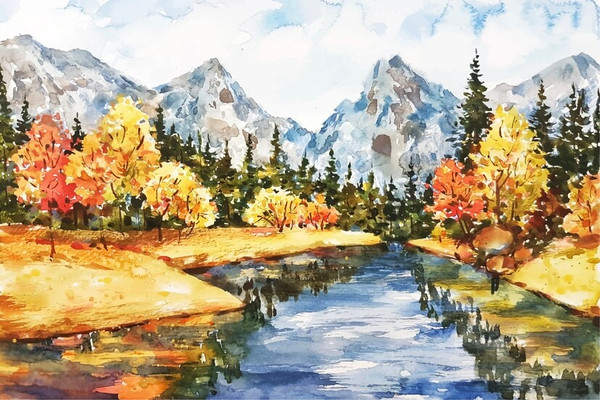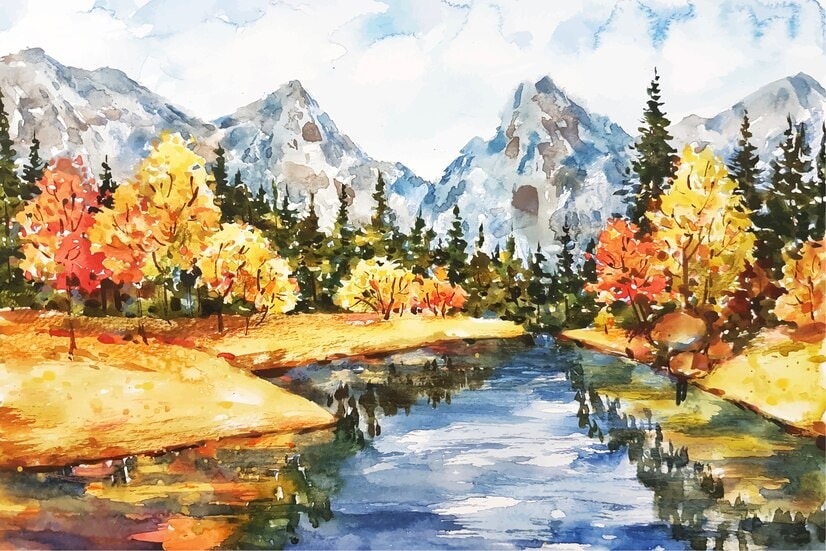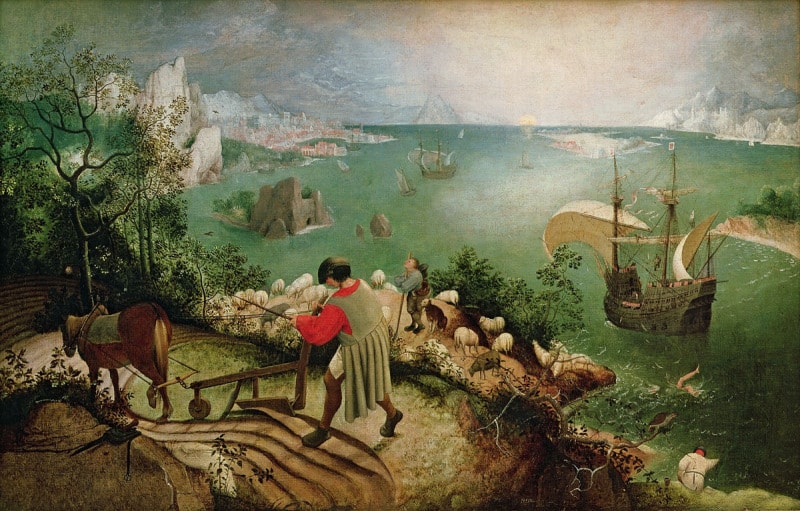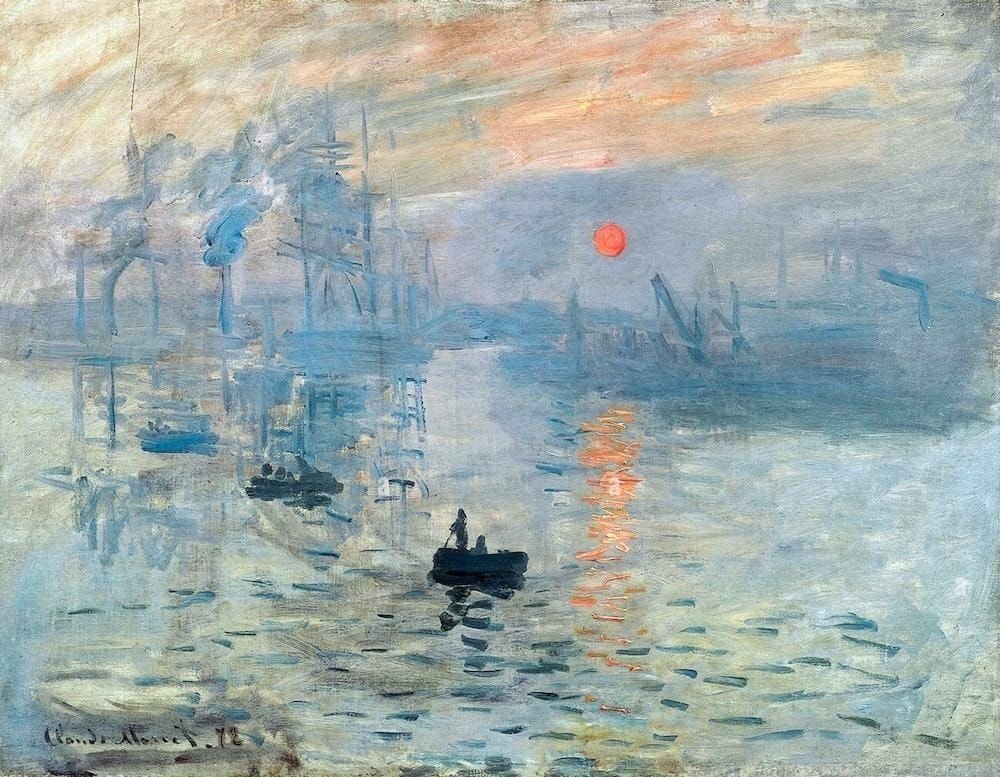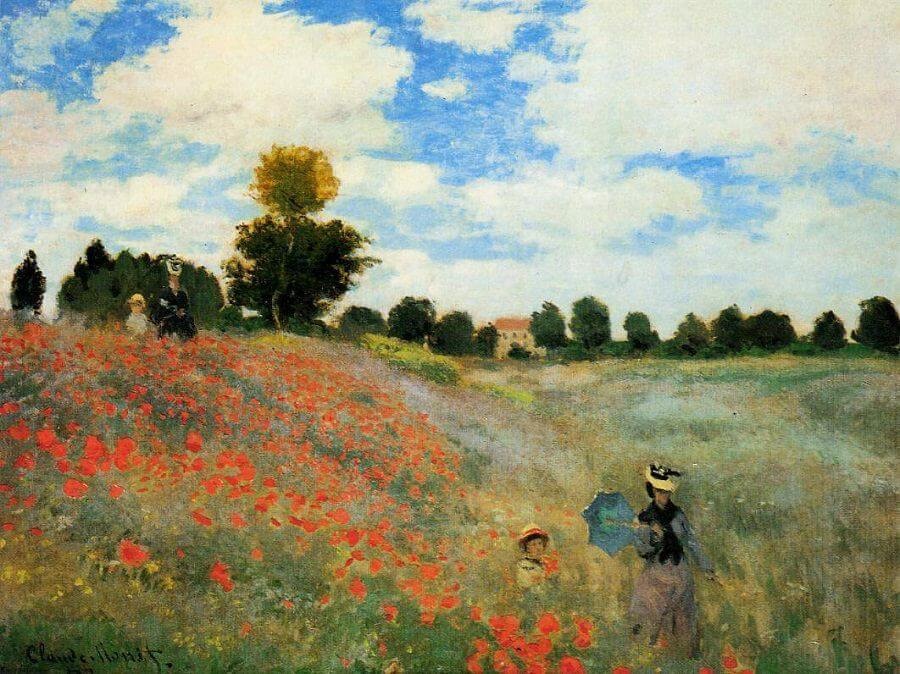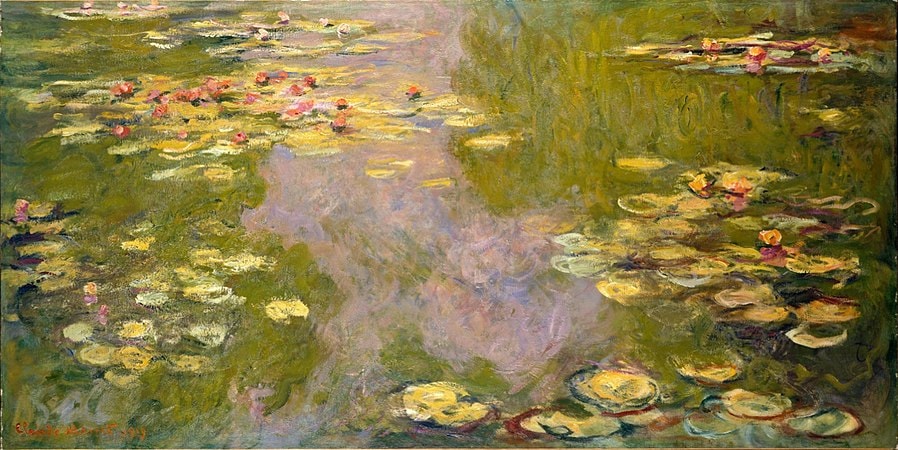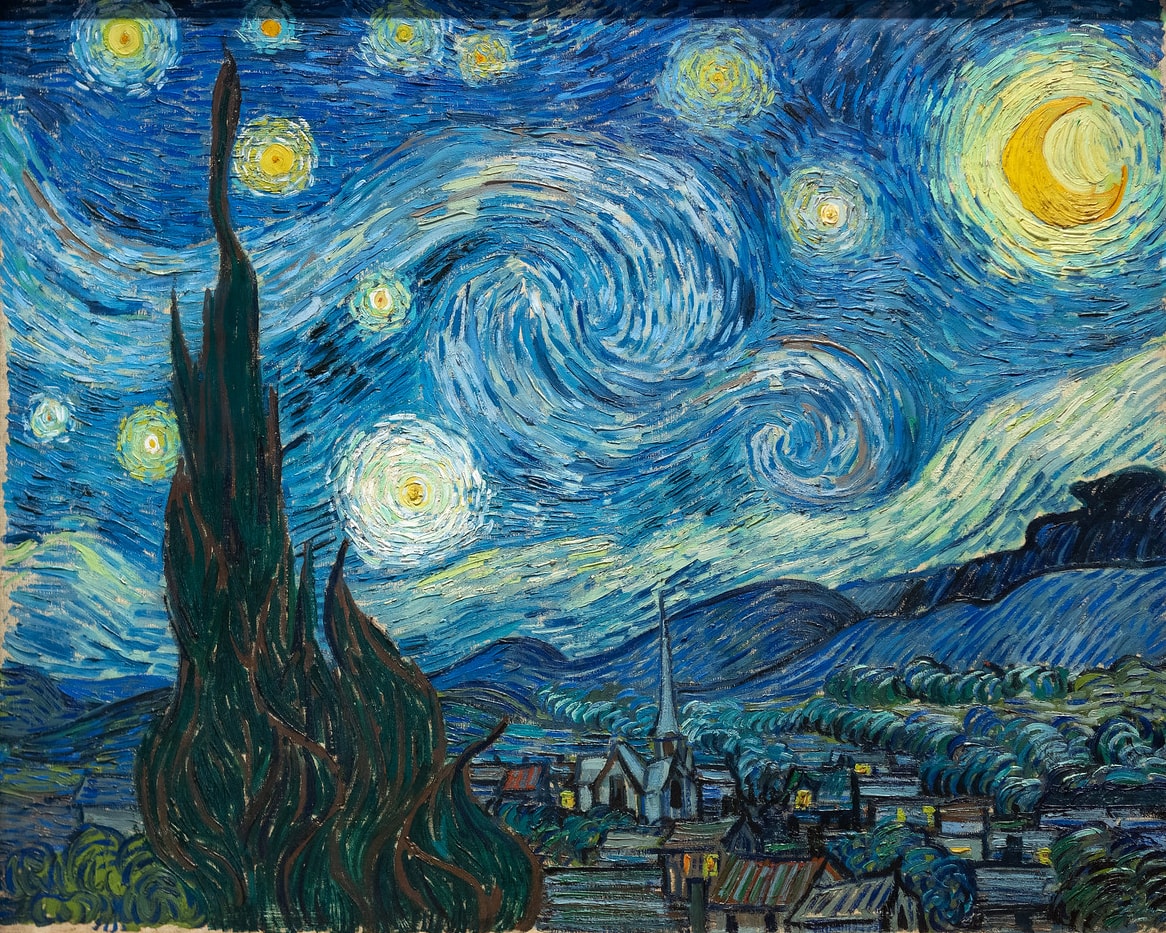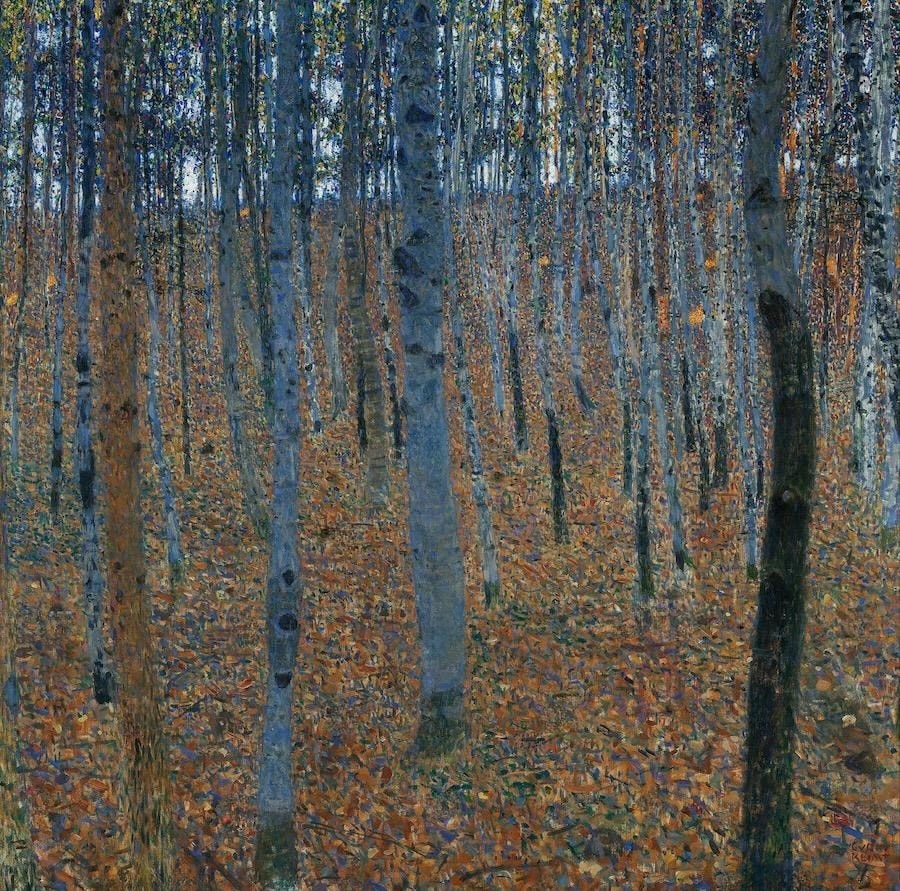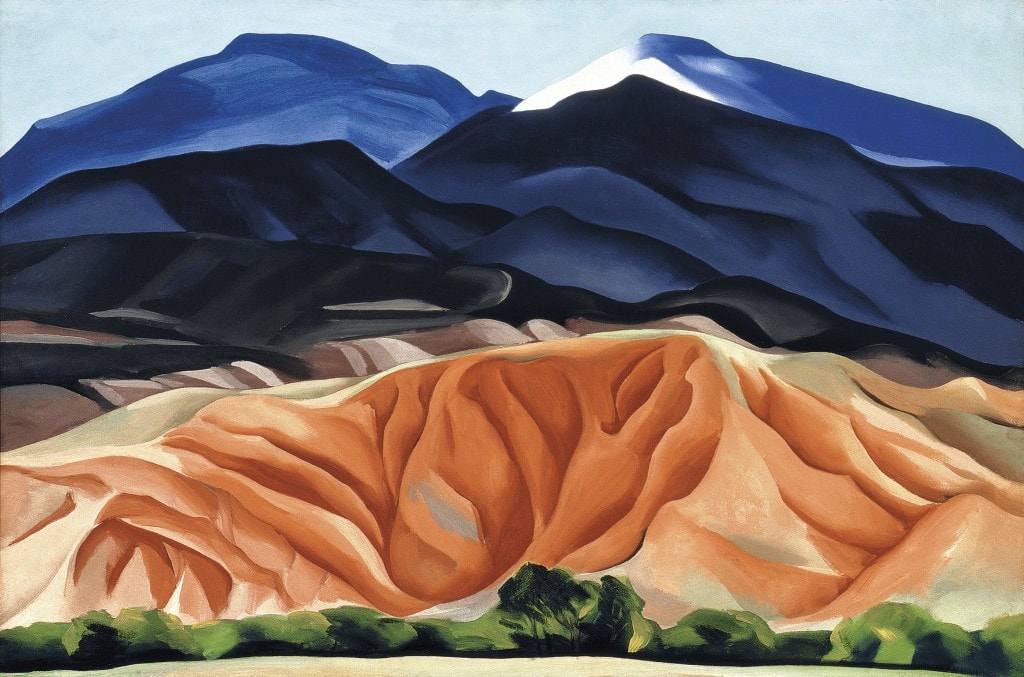25 Famous Landscape Paintings: Artistic Masterpieces to Know
Posted by MintSuper Art on 13th Jan 2025
Landscape paintings focus on nature, scenes like mountains, rivers, forests, valleys, and skies. Famous landscape artists often capture the beauty of the natural world, helping people feel connected to nature. They use their skills to create stunning views of the outdoors that can be realistic or imaginative.
These greatest landscape paintings have played an important part in art history. They show how people of different times and places saw the world around them. It often expresses emotions, culture, and spiritual meanings. Famous Artists used landscapes to paint nature, tell stories, share ideas, and inspire others.
Throughout history, landscapes have helped people appreciate the beauty of the world. Some landscape paintings show peaceful countryside scenes, while others highlight the power of nature, like stormy seas or towering mountains. These artworks remind us of the importance of preserving nature and the feelings it gives us.
Landscape art has changed significantly over time. Early paintings often depicted nature as a background for religious or historical scenes. During the Renaissance period, artists began to focus more on nature itself. The Romanticism and Impressionism movements introduced new ways to paint landscapes, emphasizing emotion, light, and color. Today, modern artists explore landscapes and nature painting with fresh ideas, blending tradition with innovative techniques.
Let us discuss these 25 famous landscape paintings with the artists and how they showed us the beauty and power of nature through their masterpieces.
Famous Landscape Paintings and Their Stories
Famous landscape paintings have shown the beauty of nature for hundreds of years. Each painting has its own story that has made a big impact on the world of art.
The Tempest – Giorgione (1506–1508)
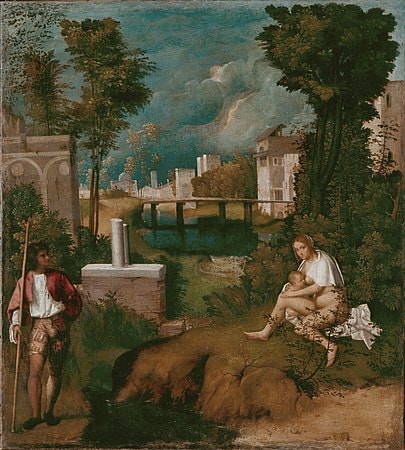
- Year of Creation: 1506–1508
- Medium: Oil on canvas
- Dimensions: 32 x 28 inches (82 x 73 cm)
- Location: Gallerie dell’Accademia, Venice, Italy
The Tempest is one of the earliest examples of landscape oil paintings as a central subject for its mysterious composition. The stormy skies create an enigmatic mood, with a solitary man and a nursing woman placed against a natural backdrop. Its meaning remains widely debated, adding to its intrigue.
Landscape with the Fall of Icarus – Pieter Bruegel the Elder (1555–1560)
- Year of Creation: 1555–1560
- Medium: Oil on canvas
- Dimensions: 29 x 44 inches (73.5 x 112 cm)
- Location: Musées Royaux des Beaux-Arts, Brussels, Belgium
Bruegel subtly integrates the mythological fall of Icarus into a bustling seascape. The painting emphasizes the indifference of daily life, where people continue their routines, unaware of the tragedy unfolding in the distance.
The Hay Wain – John Constable (1821)
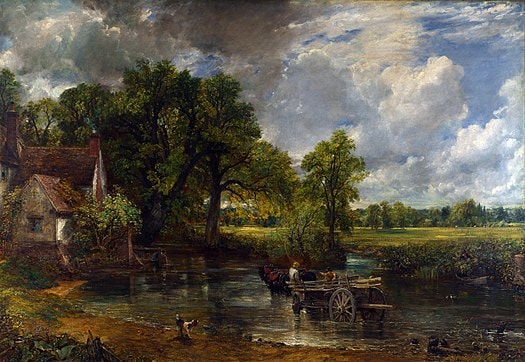
- Year of Creation: 1821
- Medium: Oil on canvas
- Dimensions: 51 x 73 inches (130 x 185 cm)
- Location: National Gallery, London, England
This painting The Hay Wain, created by John Constable portrays the peaceful countryside of rural England. It features a hay wagon crossing a shallow river near a farmhouse, highlighting the harmony between nature and daily life. His attention to detail and skillful use of natural light gives the scene depth and a calming atmosphere, making it one of the most beloved works of English landscape art.
Wanderer Above the Sea of Fog – Caspar David Friedrich (1818)
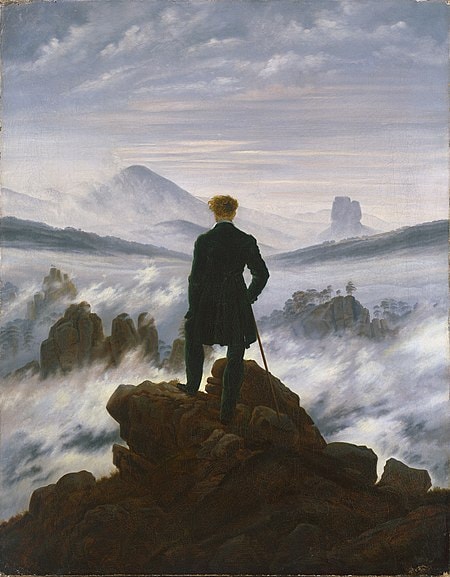
- Year of Creation: 1818
- Medium: Oil on canvas
- Dimensions: 37 x 29 inches (94 x 74 cm)
- Location: Hamburger Kunsthalle, Hamburg, Germany
This famous painting represents the Romantic era, featuring a solitary figure standing atop a rocky cliff, gazing over a mist-covered mountain landscape. The artwork emphasizes the power and mystery of nature, contrasting it with human isolation. Its dramatic composition and emotional depth inspire viewers to reflect on their place in the vast world.
Rain, Steam and Speed – The Great Western Railway – J.M.W. Turner (1844)
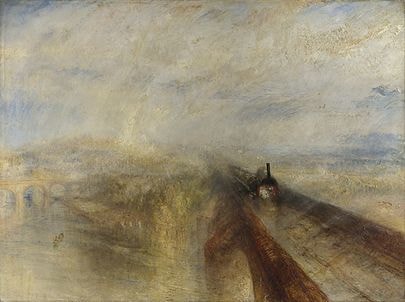
- Year of Creation: 1844
- Medium: Oil on canvas
- Dimensions: 36 x 48 inches (91 x 122 cm)
- Location: National Gallery, London, England
This painting Rain, Steam and Speed – The Great Western Railway by Turnershows the clash between nature and the rise of industry. It features a train moving quickly through a stormy landscape. The way he painted the scene with bold, fast brushstrokes helps show the strong power and energy of the steam engine during that time.
Impression, Sunrise – Claude Monet (1872)
- Year of Creation: 1872
- Medium: Oil on canvas
- Dimensions: 19 x 25 inches (48 x 63 cm)
- Location: Musée Marmottan Monet, Paris, France
Impression, Sunrise by Claude Monet was created in 1872.This famous painting inspired the Impressionist movement. Monet used quick brushstrokes and focused on light to show a bright and lively harbor at sunrise, capturing the feeling instead of the details.
The Poppy Field – Claude Monet (1873)
- Year of Creation: 1873
- Medium: Oil on canvas
- Dimensions: 23 x 32 inches (59 x 81 cm)
- Location: Musée d’Orsay, Paris, France
This painting The Poppy Field created by Claude Monet captures a tranquil summer day in the French countryside, with vibrant red poppies scattered across a lush green field. The use of soft brushstrokes and light conveys a sense of movement and atmosphere. Featuring figures strolling in the distance, the artwork reflects Monet's Impressionist style, emphasizing the beauty of nature and fleeting moments.
Water Lilies (Series) – Claude Monet (1897–1926)
- Year of Creation: 1897–1926
- Medium: Oil on canvas
- Dimensions: Varying sizes
- Location: Multiple museums worldwide, including the Musée de l’Orangerie, Paris, France
Monet’s Water Lilies series captures the tranquil beauty of his garden in Giverny, showcasing his mastery of light and reflection. These works are pivotal in the Impressionist movement and often studied for their innovative use of color and texture. The series also reflects Monet’s fascination with Japanese art, particularly ukiyo-e prints, which influenced the framing and composition of his works.
The Japanese Bridge – Claude Monet (1899)
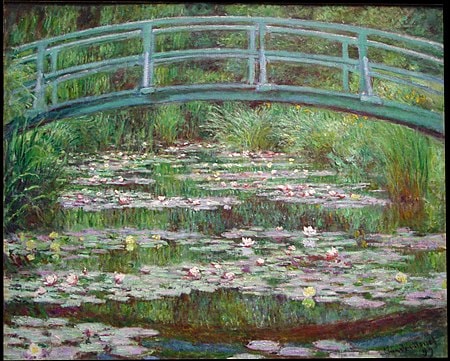
- Year of Creation: 1899
- Medium: Oil on canvas
- Dimensions: 32 x 40 inches (81 x 101 cm)
- Location: National Gallery of Art, Washington, D.C., USA
This painting features the iconic Japanese bridge in Monet’s garden. The interplay of colors and light showcases Monet’s evolving style towards abstraction. It also marks a turning point where Monet focused intensely on capturing the essence of a moment rather than its precise details, a hallmark of his later works.
The Starry Night – Vincent van Gogh (1889)
- Year of Creation: 1889
- Medium: Oil on canvas
- Dimensions: 29 x 36 inches (74 x 92 cm)
- Location: Museum of Modern Art, New York, USA
Van Gogh's paintings often reflect his emotional struggles and deep connection to nature, notably The Starry Night. Created during his time in an asylum in Saint-Rémy-de-Provence, the painting captures his fascination with the night sky through unique brushwork and a bold color palette. Scholars frequently explore its spiritual undertones, with the cypress tree symbolizing a bridge between the earth and the heavens.
Wheatfield with Crows – Vincent van Gogh (1890)
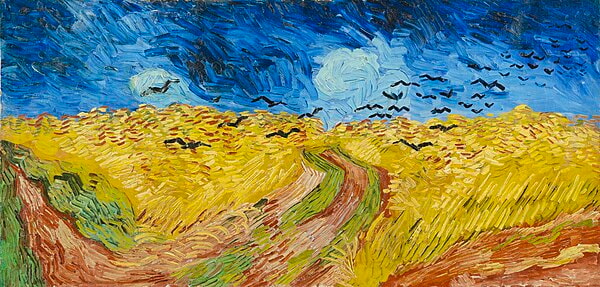
- Year of Creation: 1890
- Medium: Oil on canvas
- Dimensions: 20 x 40 inches (50.5 x 103 cm)
- Location: Van Gogh Museum, Amsterdam, Netherlands
Often interpreted as van Gogh’s last painting, Wheatfield with Crows evokes a sense of turmoil and foreboding. The painting is admired for its dynamic composition, where the winding path, stormy skies, and dark crows create a haunting atmosphere. It’s a powerful exploration of isolation and resilience, making it a subject of psychological and artistic analysis.
The Gulf Stream – Winslow Homer (1899)
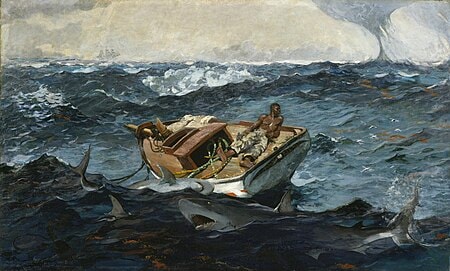
Year of Creation: 1899
Medium: Oil on canvas
Dimensions: 28 x 49 inches (71.1 x 124.5 cm)
Location: The Metropolitan Museum of Art, New York, USA
This dramatic painting by Winslow Homer portrays a lone man adrift on a damaged boat in a turbulent sea, surrounded by sharks. Winslow Homer captures the immense power of nature and the vulnerability of humans against it. The work evokes themes of survival and isolation, with its intense atmosphere and meticulous detail in the waves and sky.
Mont Sainte-Victoire – Paul Cézanne (1882–1906)
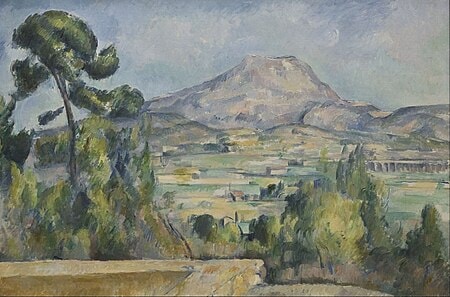
- Year of Creation: 1882–1906
- Medium: Oil on canvas
- Dimensions: Varying sizes
- Location: Multiple museums worldwide, including the Musée d’Orsay, Paris, France
Cézanne painted Mont Sainte-Victoire multiple times, experimenting with geometry and perspective. These works bridge Impressionism and Cubism, influencing artists like Picasso. Art historians often discuss how Cézanne captured the essence of the mountain’s structure and light.
The Great Wave off Kanagawa – Katsushika Hokusai (1831)
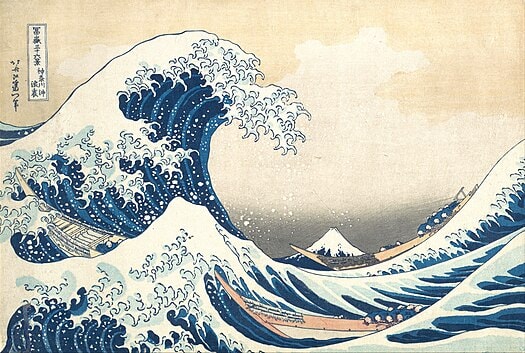
Year of Creation: 1831
Medium: Woodblock print
Dimensions: 10 x 15 inches (25 x 37 cm)
Location: Multiple collections worldwide, including the Metropolitan Museum of Art, New York, USA
Hokusai’s The Great Wave off Kanagawa is one of the most famous Japanese paintings, known for its dramatic depiction of a massive wave towering over small boats, with Mount Fuji in the distance. Its bold composition blends traditional Japanese art with Western art influences, symbolizing the power of nature and the resilience of humanity.
The Ninth Wave - Ivan Aivazovsky (1850)
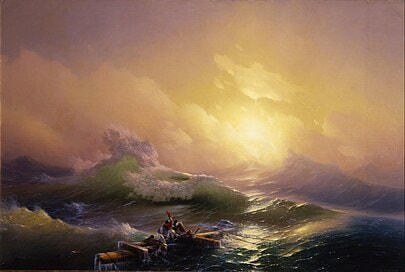
Year of Creation: 1850
Medium: Oil on canvas
Dimensions: 87 x 118 inches (221 x 299 cm)
Location: State Russian Museum, St. Petersburg, Russia
This oil painting captures survivors clinging to the remains of a shipwreck, illuminated by the warm glow of the sunrise. It symbolizes the most powerful wave in a storm, serves as both a threat and a testament to human resilience. His mastery of light and color creates a dynamic and emotional portrayal of the sea's beauty and peril.
Travelers Among Mountains and Streams – Fan Kuan (11th century)
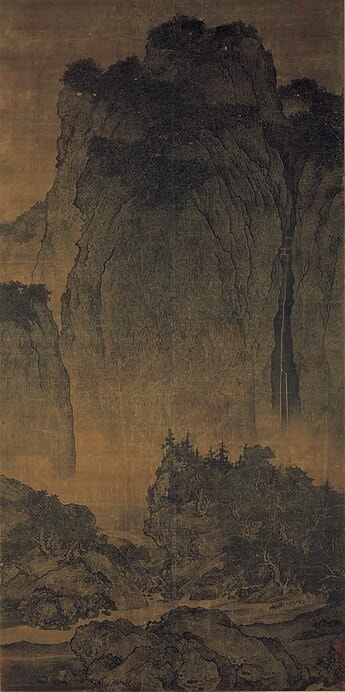
- Year of Creation: 11th century
- Medium: Ink and color on silk
- Dimensions: 81 x 41 inches (206 x 103 cm)
- Location: National Palace Museum, Taipei, Taiwan
Fan Kuan’s painting represents the grandeur of nature, with its towering mountains and small human figures emphasizing humility and spiritual reflection. It is a cornerstone of Chinese landscape painting, reflecting Daoist and Confucian philosophies, and showcases the majestic and timeless characteristics of the natural world.
Christina’s World– Andrew Wyeth (1948)
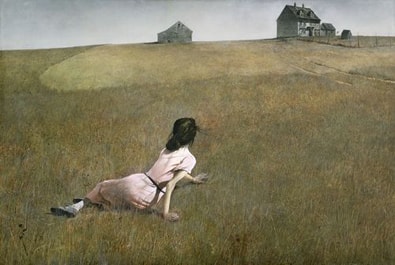
- Year of Creation: 1948
- Medium: Egg tempera on panel
- Dimensions: 32 x 48 inches (82 x 121 cm)
- Location: Museum of Modern Art, New York, USA
Christina's World by Andrew Wyeth, created in 1948, explores the feelings of being alone and staying strong despite difficulties. The painting is inspired by Wyeth’s neighbor, Christina Olson, who had a muscular disorder that made it hard for her to walk. She is shown lying in a field, looking towards a distant farmhouse. This powerful image shows her determination to keep going, even though she couldn’t move easily. The painting is often talked about because of how it is arranged and the deep emotions it brings, making viewers feel her struggle and strength.
Niagara Falls – Frederic Edwin Church (1857)
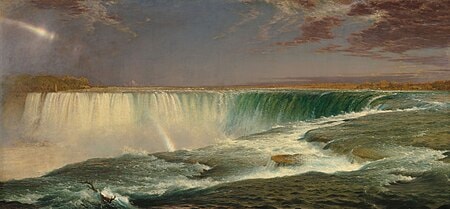
- Year of Creation: 1857
- Medium: Oil on canvas
- Dimensions: 40 x 90 inches (101.6 x 228.6 cm)
- Location: Corcoran Collection, National Gallery of Art, Washington, D.C., USA
This beautiful painting by Frederic Edwin Church shows the amazing power of Niagara Falls, with its rushing water and misty air. Church's careful details and use of light make the scene feel grand and full of energy. The painting reflects how people in the 1800s admired the beauty and greatness of nature, inviting viewers to appreciate the size and wonder of the falls.
The Monk by the Sea - Caspar David Friedrich (1808-1810)
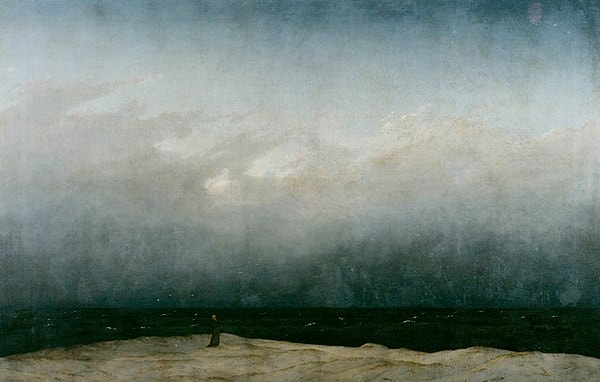
- Year of Creation: 1808–1810
- Medium: Oil on canvas
- Dimensions: 43 x 67 inches (110 x 171 cm)
- Location: Alte Nationalgalerie, Berlin, Germany
The Monk by the Sea (1808–1810) by Caspar David Friedrich shows a monk standing alone by a big, stormy sea. The monk is small compared to the huge ocean and sky, which makes the painting feel lonely and thoughtful. The soft colors and large space make us think about being alone and reflecting on life. This painting is part of the Romantic movement, which focuses on emotions and the power of nature which invites us to think about our place in the world.
The Grand Canal at the Church of La Salute - Giovanni Antonio Canal (Canaletto) (c. 1730)
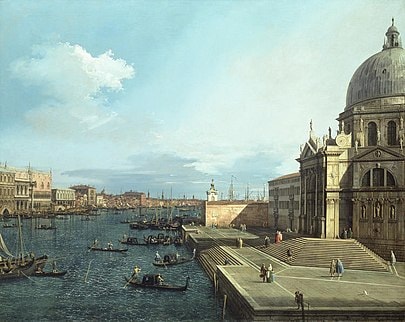
Year of Creation: c. 1730
Medium: Oil on canvas
Dimensions: 18 x 30 inches (46 x 76 cm)
Location: National Gallery, London, UK
This painting shows a busy view of Venice’s Grand Canal, with the beautiful Church of Santa Maria della Salute. Canaletto carefully paints the shimmering water, the grand buildings, and the lively gondolas. His skill in capturing perspective and light makes the scene come alive, showcasing his talent in cityscape painting.
Birch Forest - Gustav Klimt (1903)
- Year of Creation: 1903
- Medium: Oil on canvas
- Dimensions: 39.4 x 39.4 inches (100 x 100 cm)
- Location: Österreichische Galerie Belvedere, Vienna, Austria
This painting shows a peaceful forest filled with slender birch trees. Klimt uses rich colors and patterns to create a sense of harmony and depth, capturing the beauty of nature. The golden sunlight filtering through the trees adds a magical quality, making the forest feel alive and inviting. This work reflects Klimt’s unique style and his love for nature’s quiet elegance.
Black Mesa Landscape, New Mexico - Out Back of Marie's - Georgia O'Keeffe
Year of Creation: 1930
Medium: Oil on canvas
Dimensions: 30 x 40 inches (76 x 102 cm)
Location: Georgia O’Keeffe Museum, Santa Fe, New Mexico, USA
This painting portrays the rugged beauty of New Mexico’s Black Mesa, a recurring subject in O'Keeffe's work. With bold, simplified forms and earthy tones, the artwork reflects her deep connection to the southwestern landscape. The composition highlights the timeless and stark beauty of the desert, emphasizing solitude and harmony with nature.
The Oxbow - Thomas Cole (1836)
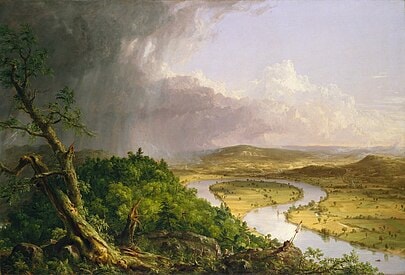
Year of Creation: 1836
Medium: Oil on canvas
Dimensions: 51 x 76 inches (130 x 193 cm)
Location: The Metropolitan Museum of Art, New York, USA
This iconic painting juxtaposes untamed wilderness with cultivated farmland, symbolizing the tension between nature and human progress. The dramatic view from Mount Holyoke in Massachusetts features a storm clearing over the Connecticut River, creating a wonderful landscape that captures the essence of both natural beauty and human intervention. Rich in symbolism, The Oxbow is considered a masterpiece of the Hudson River School and a reflection on America's relationship with its natural landscape.
L’Estaque - André Derain (1906 )
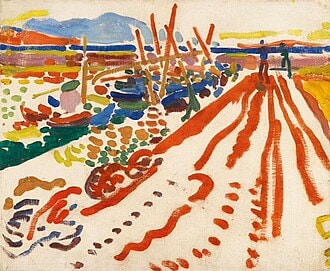
- Year of Creation: 1906
- Medium: Oil on canvas
- Dimensions: 26 x 36 inches (66 x 91 cm)
- Location: Centre Pompidou, Paris, France
This Fauvist painting captures the vibrant and sunlit coastal village of L’Estaque in southern France. Derain’s use of bold, unblended colors and simplified shapes conveys the energy and warmth of the Mediterranean. The painting is celebrated for its dynamic composition and experimental style, which helped define the Fauvist movement alongside works by Henri Matisse.
Key Art Movements in Landscape Paintings
Landscape art has evolved through numerous movements, each bringing unique styles and perspectives:
- Romanticism: Focused on emotional intensity and the sublime beauty of nature.
- Impressionism: Emphasized light and color with loose, dynamic brushstrokes.
- Post-Impressionism: Explored structure and symbolic content.
- Realism: Captured ordinary scenes with meticulous detail.
- Baroque: Featured dramatic contrasts and grandeur.
- Renaissance: Balanced nature and human elements harmoniously.
- Modernism: Pushed boundaries with abstract and experimental forms.
- Expressionism: Conveyed emotional responses to landscapes.
Themes and Cultural Influences in Landscape Art
Themes in Landscape Art
Landscape art often explores universal themes such as the transience of time, the fleeting nature of moments, and the changing of seasons, as seen in the Impressionist movement. It also reflects the deep connection between humans and nature, portraying landscapes as a source of spiritual or emotional inspiration. Additionally, many landscape paintings highlight the impact of industrialization and human progress, depicting the tension between untouched nature and the encroachment of human development, as seen in works like The Oxbow by Thomas Cole.
Cultural Influences in Landscape Art
Cultural perspectives play a significant role in shaping landscape art. Chinese scroll paintings often emphasize harmony and balance with nature, reflecting Taoist and Buddhist philosophies that seek peaceful coexistence. In contrast, Western landscapes, especially during the Romantic period, highlight the grandeur of nature and the human struggle to understand or conquer it. Meanwhile, movements like Fauvism were influenced by the vibrant Mediterranean light and colors, breaking away from realism to express emotional energy through bold, non-naturalistic colors, as seen in André Derain’s L’Estaque.
Conclusion
Landscape and nature paintings offer a glimpse into humanity's bond with nature, highlighting its beauty and intricacy. These timeless famous paintings cross cultural and historical boundaries, leaving a lasting impact on the art world. Their lasting charm lies in their power to spark introspection, awe, and connection. For further inspiration and to discover a world of artistic wonders, visit Mintsuper Art.

